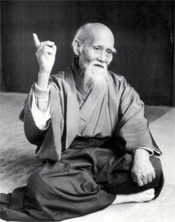Ueshiba Morihei O-sensei
(1883-1969)

Ueshiba Morihei was born in Tanabe, Wakayama Prefecture Japan, in December 14, 1883. Whilst his ancestors were strong and skilled martial artists, he was frequently ill in his childhood. Although later he performed superhuman acts, his physique remained slightly fragile throughout his life.
In his childhood besides studying Chinese classics, he got a glimpse of the rites of esoteric Buddhism, also known as Shingon. His early religious interest only strengthened through the years.
At the age of 12 his father was attacked by hoodlums who were hired by his political opposites. This shock made him decide to devote his life to Budo. With years of hard work he mastered the Shinkage-ryu kenjutsu (sword play) and the Tenshin Shin’yo-ryu ju-jutsu. During his military service he met Yagyu-ryu ju-jutsu, Hozoin-ryu spear fencing, and the art of bayonet fencing.
After his decommissioning,in the government’s program, he travelled to Hokkaido with 80 farmers to create value from nothing. Through the years, despite the hardships, they made results and Morihei was a highly respected man in Shirataki. In Hokkaido he met Takeda Sokaku (master of Daito-ryu ju-jutsu), who changed his Budo attitude. Morihei built a dojo for him, and became his apprentice. Later because of his father’s serious illness he sold off everything and returned to Tanabe.
During his travel home he stopped in Ayabe, where a charismatic Shinto priest, Deguchi Onisaburo, teached. He asked Onisaburo to pray for his father’s recovery. This encounter with Onisaburo made a great impact on him. Later he settled in Ayabe and became an enthusiastic follower of the Omoto-kyo (doctrine of the Great Origin) religious sect. Here he recognized that his spiritual path had two pillars, the hard practice in martial arts and the in-depth study of philosophical and religious teachings. This relationship with Onisaburo started the formation of Aikido.
Inspired by the ideas of Omoto-kyo in 1924 he accompanied Onisaburo as bodyguard to Inner Mongolia, to establish the Kingdom of Peace, a true earthly paradise. Their expedition almost ended with a tragedy. After his return during a duel with a naval officer he reached Satori: it was enlightened in his mind that real Budo is not based on destruction, but on the protection of all living things and love. His reputation has grown throughout the country, in Tokyo he held presentations and later practices for senior statesmen and soldiers. When Jigoro Kano, founder of Judo saw Ueshiba Sensei’s presentation, he named his art ‘the ideal Budo’ and sent his disciplines to O-Sensei.
In 1931 he founded the central Dojo in Tokyo named Kobukan (it means searching for truth with exceeding the level of everyday consciousness). In the beginning the Dojo was called “the Dojo of Hell” because of its hard and ascetic trainings and committed disciples. After this, inspired by Onisaburo, the Budo Development Association was founded and Ueshiba Sensei was the chief instructor. Several dojos were founded through Japan, mainly where Omoto-kyo followers lived, and O-Sensei’s fame spread further.
There was a crucial point in O-Sensei’s life on December 14, 1940. In his dream a celestial messenger appeared before him, and told him that the Dragon King, the godly force, which destroys Evil and brings peace to the world , takes possession of his soul. Because of this shocking experience he was ill for a year. After his recovery he considered Aikido as a heavenly mission to be distributed for the benefit of mankind.
In 1942 he condemned Japan’s politics in the 2nd World War and retired to Iwama. Until then Aiki Budo was classified as an official Budo style by the government and was used in propaganda. Because of this Ueshiba Sensei officially renamed his style to Aikido in February 1942. The rural life meant the return to his origins for O-Sensei. The complementary lifestyle, cultivation of land -care of life, and the Budo -protection of life, took him further along on the way of Aikido.
After the 2nd World War and under US pressure the practice of martial arts was banned, so the Hombu Dojo moved from Tokyo to Iwama where Ueshiba Sensei continued to teach. In 1948 the trainings started again in Tokyo. From this time on O-Sensei’s Aikido set out to conquer the world.
Ueshiba Morihei, founder of Aikido died on April 26, 1969. His last teaching was that
“Aikido is for the whole world. Never practice it for your own sake, always for the other person.”
After his death the Emperor honored him with the Order of the Sacred Treasure. A memorial service is held each year at the Iwama Aiki Shrine.